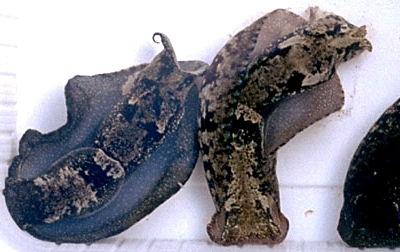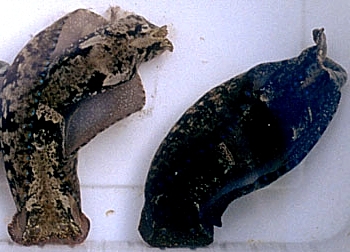Chilean Navanax aenigmaticus
March 14, 2007
From: Michael Schroedl

I have collected opisthobranchs along the continental coast of Chile for several years. In that time I have only once found an aglajid species, and that was at Juan López, near Antofagasta, northern Chile, on 26 February 1994. Three large specimens (8.5-10 cm; photograph attached) were crawling around openly during daytime, and were more or less easily visible between algae on rocks and on the sandy bottom of a protected bay at 3-5 m depth. Water temperature was exceptionally high (21°C) there. On 17 March 1994 we found another individual in the same bay, however, at temperatures of 16° C which was still higher than temperatures we measured at other places along the central and northern Chilean coast in March 1994.
Their body shows a head shield with rounded posterior border, bifid posterior lobes and large parapodia. The ground coloration of head shield, visceral shield and ventral parapodia varies from reddish brown to very dark brown and is more or less extensively mottled with white, except for the foot sole area which shows whitish or yellow dots. The dorsal portion of parapodia is brighter and looks faded, with whitish dots. All specimens show a characteristic row of small blue spots along the parapodial margin, thus leaving little doubt that they are Navanax aenigmaticus.
This present record extends the Pacific range of N. aenigmaticus from tropical Panamic waters and Galapagos (see Behrens & Hermosillo, 2005) far south into the temperate Humboldt Current system. In the absence of adequate surveys it cannot be decided yet whether N. aenigmaticus is a regular member of the Chilean fauna occurring at least at locations with special environmental conditions, or just a sporadic guest. Growing up to 10 cm in length, eastern Pacific N. aenigmaticus may grow considerably larger and more bulky than supposedly conspecific Caribbean specimens (up to 5 cm according to Valdés et al., 2006), and do not seem to show the longitudinal notal and parapodial stripes which are at least usually present in Atlantic individuals. It would be worth investigating whether or not such differences are true and consistent in such geographically clearly defined and separated populations. Whatever its taxonomic implications, we would expect at least a certain degree of divergence had evolved during the last roughly 3 million years. The rise of the Isthmus of Panama is an evolutionary experiment designed by nature which, regarding opisthobranchs, still waits for somebody performing (also molecular) analyses.
-
Behrens, D.W. & A. Hermosillo. 2005. Eastern Pacific nudibranchs. Sea Challengers, Monterey. 137 pp.
-
Valdés, À, Hamann, J., Behrens, D.W. & A. DuPont. 2006. Caribbean sea slugs. Sea Challengers, Gig Harbour. 289 pp.
Michael Schrödl
schroedl@zi.biologie.uni-muenchen.de
Schroedl, M., 2007 (Mar 14) Chilean Navanax aenigmaticus. [Message in] Sea Slug Forum. Australian Museum, Sydney. Available from http://www.seaslugforum.net/find/19659
Dear Michael,
Thanks for this interesting record. Certainly the records of this species from the Eastern Pacific on the Forum, lack the longitudinal lines which normally occur in Atlantic specimens, but there is at least one example from the Caribbean [message #11126] of an animal without lines. However the pattern of dark blotches is quite consistent from both oceans. It reminds be of colour variability in Chromodoris striatella . For those of you who aren't familiar with Navanax aenigmaticus, it was originally described from the Pacific coast of Panama, so if future studies show the Atlantic form to be distinct, then there are a number of names, such as Navanax evelinae (Marcus, 1955), which are available.
Best wishes,
Bill Rudman
Related messages
-
The strange Chilean 'sinistrobranch' Posterobranchaea
From: Michael Schroedl, March 15, 2007 -
West African Navanax aenigmaticus
From: M. Schroedl, P. Ryall, T. Gertin, T. Neusser, March 14, 2007 -
Navanax aenigmaticus from Brazil
From: Wagner Torres, June 14, 2005 -
Navanax aenigmaticus from Brazil
From: Vinicius Anderson, November 15, 2003 -
Navanax aenigmaticus from Jamaica
From: Ross W. Gundersen, October 18, 2003 -
Navanax aenigmaticus from Caribbean
From: Nestor E. Ardila, March 5, 2003 -
'Aglaja evelinae' from Belize
From: Dave Behrens, October 11, 2002 -
Navanax aenigmaticus from Costa Rica
From: Peter Ajtai, May 25, 2002 -
Feeding behaviour of Navanax aenigmaticus
From: Alicia Hermosillo, May 14, 2002 -
Color variation of Navanax aenigmaticus
From: Alicia Hermosillo, March 9, 2002 -
Ink from Navanax aenigmaticus
From: Elianny Domínguez Tejo, June 9, 2001 -
Navanax inermis in Brazil?
From: André Mazeron, February 20, 2001 -
Navanax aenigmaticus synonymous?
From: Phanor Montoya, February 5, 2001 -
Information on Navanax aenigmaticus
From: alecia, January 21, 2001 -
Navanax aenigmaticus from Colombia.
From: Phanor Montoya, October 3, 2000
